
Papiere für Welte Mignon Notenrollen T100 (rot)
In der Zeit um 1900 haben mit Sicherheit weder Hupfeld noch Welte oder ein anderer Hersteller daran gedacht, dass deren Notenrollen nach über 100 Jahren immer

In der Zeit um 1900 haben mit Sicherheit weder Hupfeld noch Welte oder ein anderer Hersteller daran gedacht, dass deren Notenrollen nach über 100 Jahren immer

Gleich vorneweg – die folgenden Aussagen ersetzen keine Rechtsberatung und erheben keinen Anspruch auf Korrektheit oder Vollständigkeit, jegliche Haftung wird ausgeschlossen. Im konkreten Falle wenden Sie

In 2020 digitalisierte die Stanford University / Stanford Libraries das tatsächlich noch erhaltene AMPICO ARTIST RECORD Buch (308 Seiten) aus den späten 1920er Jahren, das Alan H.

Die meisten Stücke, die auf Reproduktionsrollen aufgenommen worden, sind Piano Solo Stücke. Gleichwohl wurden auch Rollen hergestellt, die zur Liedbegleitung gedacht waren und so damals wie

Nach Ausbruch des Ersten Weltkrieges wurde es zunehmend schwierig die Welte Geschäfte in den USA zu führen. 1917 wurden nach Eintritt der USA in den WWI

Die Phillips AG in Frankfurt brachte ab 1923 das Reproduktionssystem DUCARTIST auf den Markt. Das DUCARTIST ist das DUCA auf Basis einer 88er Standardskala. Philipps hat

Für das ab 1919 gebaute Reproduktionssystem Triphonola wurde eine Normskala verwendet, so dass auch die Standard 88er Notenrollen spielbar sind. Für die Reproduktion wurden aber auch

Angesichts der vergleichsweise hohen Preise (ca. ein durchschnittliche Jahreseinkommen) der Pianola und Vorsetzer sowie auch der zugehörigen Notenrollen besaßen vorwiegend wohlhabende und sehr reiche Personen diese

Es konnten nur sehr gut situierte Miglieder der wachsenden oberen Mittelschicht sowie der reichen und sehr reichen Oberschicht ein Pianola erwerben und Notenrollen hinzukaufen. Bedenkt man,

Wie so oft bei großen Entwicklungen waren es mehrere geniale Personen, die Welte-Mignon zu diesem Welterfolg gemacht haben. Bockisch-Welte-Popper-Feurich (Foto aus der Zeitschrift für Instrumentenbau No

Hugo Popper brachte 1908 das Reproduktionsklavier Stella auf den Markt und warb mit einem eigenen Aufnahmeapparat und einem eigenen exquisiten Repertoire. Tatsächlich scheint das Popper Stella

Die US Amerikanischen Welte-Licensee Rollen ähneln den Duo-Art und Ampico Notenrollen. Nach der Enteignung zum ersten Weltkrieg wurden die Amerikanischen Welte Geschäfte in den USA verkauft

Die Ampico Rollen basieren ebenfalls auf dem 88er Standardformat und haben zusätzlich die für die Reproduktion notwendigen Lochungen, so dass 83 Töne Gespielt werden. Die Ampico

Die Duo-Art Rollen der Aeolian Company basieren auf dem 88er Standardformat und haben zusätzlich die für die Reproduktion notwendigen Lochungen. Man kann die Duo-Art Notenrollen daher

1908 hat Philipps mit DUCA ein Konkurrenzsystem zur Hupfeld DEA und zum Welte-Mignon im Markt präsentiert. DUCA konnte einen Ton mehr anspielen als die beiden Konkurrenzsysteme

1919 hat Hupfeld die Weiterentwicklung des DEA Reproduktionssystem mit den Möglichkeiten der 88er Phonola verbunden und das Triphonola entwickelt, um 11 Jahre nach dessen Standardisierung auch

Als Hupfeld das DEA Reproduktionssystem ab 1907 anbot, konnte Hupfeld bereits auf die Phonoliszt bzw. Phonola Künstleraufnahmen zurückgreifen, die mindestens seit 1905 aufgezeichnet wurden. Wenngleich auch

Notenrollen für das ab 1924 hergestellte Welte-Mignon T98 System werden zumeist „Welte grün“ Rollen genannt, da das verwendete Papier meistens auffällig grün war. Auf den roten

1904 hat M. Welte & Söhne aus Freiburg die Welte-Mignon Notenrollen als erste Reproduktionsrollen auf den Markt gebracht. Die Welte-Mignon T100 Rollen werden zumeist „Welte rot“

Im 88er Standardformat wurden sehr viele Notenrollen unterschiedlicher Hersteller auf den Markt gebracht. Unter ihnen natürlich vor allem die Aeolian Company bzw. deren Deutsche Niederlassung Choralion

Die Hupfeld Notenrollen mit der 88er Skala wurden ab 1912 eingeführt und mit dem eingetragenen Warenzeichen „Animatic“ tituliert. ‚Anima‘ abgeleitet von ‚Seele‘. Diese Notenrollen sprechen alle
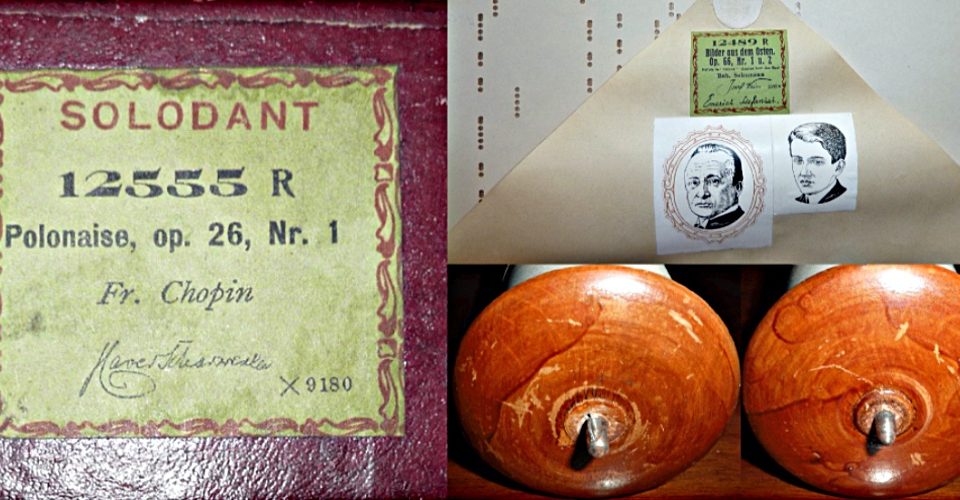
Hupfeld war in Deutschland der größte Anbieter für Künstlernotenrollen für die eigenen Hupfeld Phonola Kunstspielinstrumente. Die Phonola Notenrollen mit der 72/73er Skala wurden ab 1902 zunächst

Die Notenrollen mit einer Standard 65er Skala wurden von Aeolian bereits ab 1897 in Amerika mit der Pianola als Vorsetzer vermarktet und kamen damit noch vor

Die allermeisten Rollen lassen sich sehr leicht an bestimmten Merkmalen erkennen. Manche eher seltene Rollentypen geben zunächst Rätsel auf – und benötigen eine genauere Untersuchung. Die

Nach den Kriegen sind leider keine Aufnahmeflügel erhalten –und aus Geheimhaltungsgründen wurden auch keine Konstruktions- oder Patentunterlagen dazu veröffentlicht, so dass es bis heute nicht ganz

Sehr. Und das ist auch gut so. Selbst in dem Bemühen, so authentisch wie möglich die Idee und die Vorgaben des Komponisten umzusetzen, spielen Pianisten unterschiedlich.

Auch wenn die bis über 100Jahre alten Notenrollen oft noch gut erhalten sind, finden sich bei vielen Rollen allein durch die mehrfache Nutzung kleinere oder größere

Birgit Heise und ihr Team haben einen sehr interessanten Artikel in der DMM (Sep 2017) veröffentlicht – Thema: Die Künstlerverträge von Hupfeld. Diese Unterlagen sind Teil

Die verfügbaren Titel auf Notenrollen richteten sich nach dem jeweiligen Zeitgeschmack, der regional – also in Deutschland anders als in den USA- durchaus unterschiedlich war. Gleichzeitig

Wie auch bei Pianolas, unterscheiden sich die Notenrollen deutlich nach Hersteller, Alter und Typ. Es existieren zahlreiche unterschiedliche Rollentypen und diese passen jeweils nur für bestimmte

1908 brachte Hugo Popper in Leipzig das Reproduktionsinstrument ‚Stella‘ auf den Markt. Es ist technisch dem Welte-Mignon sehr ähnlich. Die Rollenbreite und Skala ist jedoch abweichend.

1913 gab es den Vorläufer (Stoddard-Ampico), ab 1920 dann das ausgereifte Ampico A und ab 1929 die Weiterentwicklung -das Ampico B. Als die letzte Entwicklungsstufe aller

Das Ampico Reproduktionssystem der American Piano Company war -wie das Aeolian Duo-Art- vor allem im Heimatmarkt USA und in UK sehr erfolgreich und ist auch heute

Die Aeolian Company New York hat -anders als anfangs Welte, Hupfeld und Philipps- für das ab 1913 vermarktete Reproduktionssystem Duo-Art eine 88er Normskala verwendet, ergänzt um

Die Phillips AG in Frankfurt brachte ab 1908 das Reproduktionssystem DUCA auf den Markt. Wie wichtig die Alleinstellungsmerkmale im Leistungsumfang gegenüber dem Hauptkonkurrenten auch damals schon

Die Hupfeld AG in Leipzig hat zusätzlich zu der sehr erfolgreichen Phonola das DEA (lat. „Göttin“) Reproduktionssystem 1907 auf den Markt gebracht. Damit wollte die Hupfeld

Erst 1924 führte Welte das T98 Welte grün Reproduktionssystem ein. Es wurde ein Notengleitblock mit 102 Lochungen (inkl. Notenbandführung) verwendet – das Reproduktionssystem kann 88 Töne

Die T100 Skala von M. Welte & Söhne (Freiburg) war das erste Reproduktionssystem dieser Art und erregte weltwundergleiches Aufsehen in 1904/1905. T100 bezieht sich dabei auf

Die 88er Standard- oder Normskala wurde auf einem Kongress 1908 in Buffalo/USA festgelegt. Nach und nach bauten ab 1910 dann die meisten Hersteller die 88er Skala.
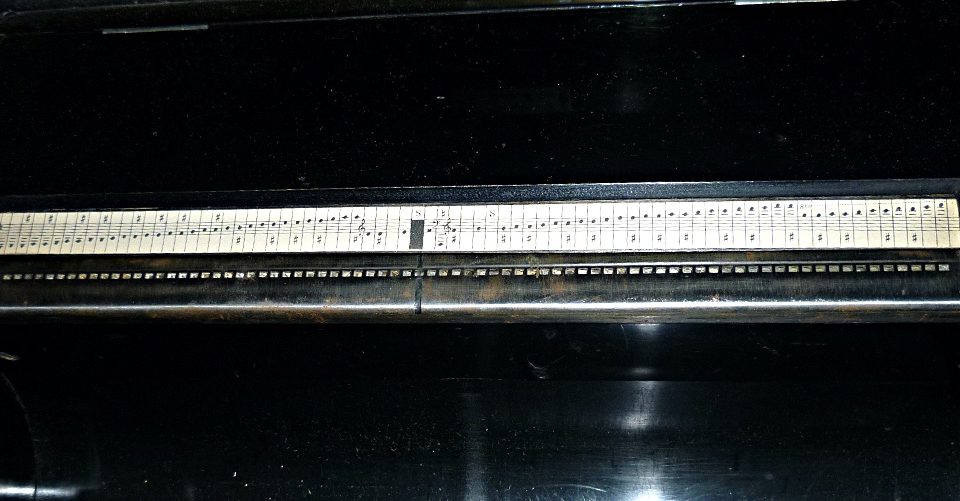
Die eigentlich 72er Skala wurde ~1902 von Hupfeld auf den Markt gebracht, um mit größerem Tonumfang und geteilter Windlade (separate Dynamik von Bass und Diskant) im

Die 65er Skala wurde von Aeolian bereits ab 1897 in Amerika mit der Pianola als Vorsetzer vermarktet und kam noch vor der Hupfeld Phonola auch auf

Das Grundprinzip aller Pianolas ist gleich. Stark vereinfacht: Über Tret-Pedale oder elektrisch betriebenes Saugluftgebläse wird ein Unterdruck im geschlossenen Selbstspielmechanismus erzeugt. Über eine Abspiel- und eine
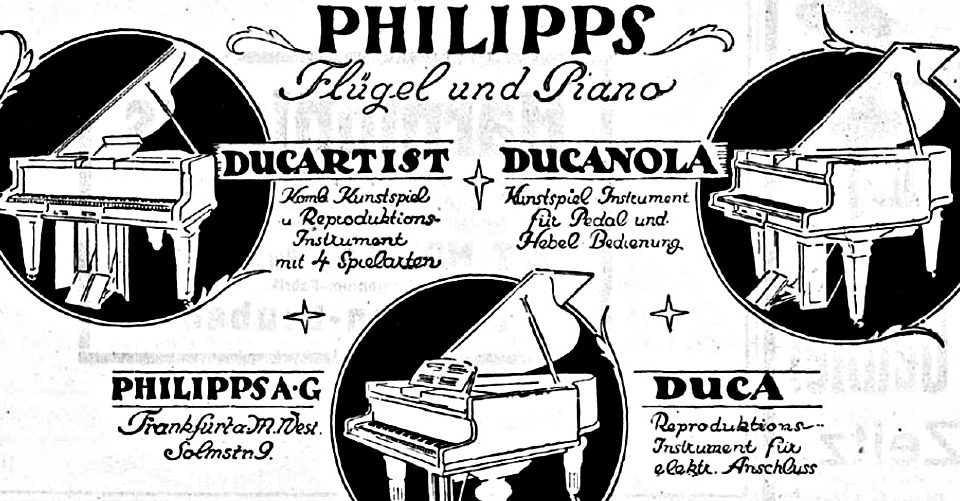
„Pianola“ als Sammelbegriff für selbstspielende Klaviere und Flügel lässt kaum auf die große Vielfalt dieser Instrumente schließen. Diese Vielfalt ist durch die sukzessive Weiterentwicklung der technischen

Der Name „Pianola“ ist eigentlich ein Produktname für den um 1895 von Edwin Votey gebauten Selbstspielmechanismus, der ab 1897 durch die Aeolian Company New York sehr
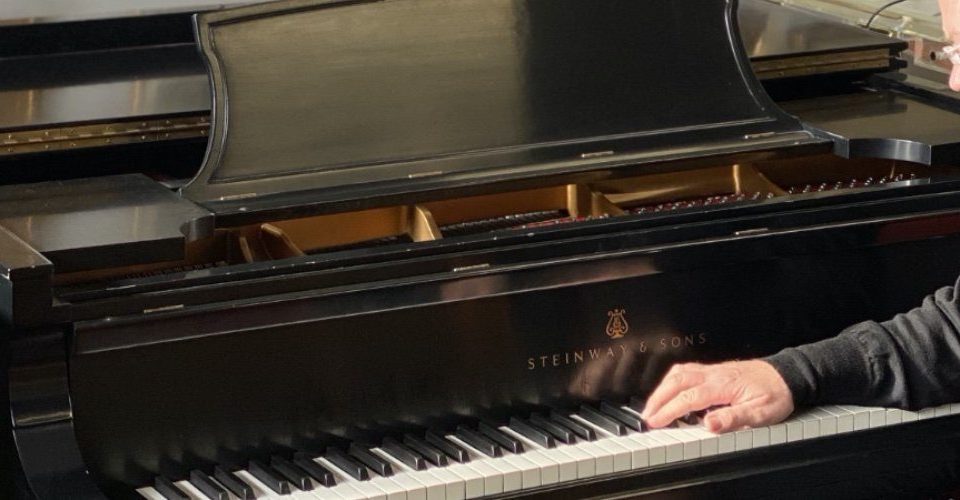
Das schöne Zitat von Franz Liszt, „Mein Klavier ist für mich, was dem Seemann seine Fregatte, dem Araber sein Pferd, mehr noch, meine Sprache, mein Leben!“,

Um sich ein wenig vertraut zu machen mit dem Aufbau des Instrumentes, erfolgt hier eine kurze Beschreibung der wesentlichen Elemente. Eine detailliertere Beschreibung der einzelnen Elemente
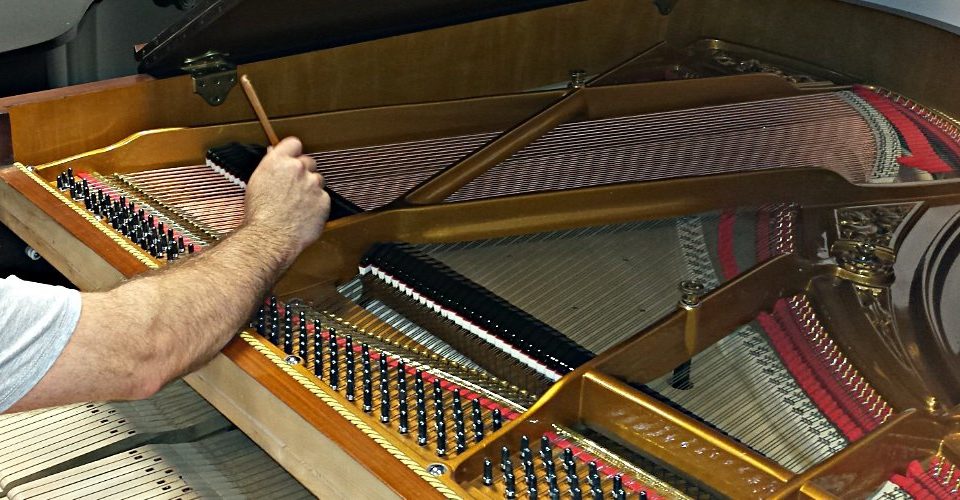
Da das Piano und nicht das Pianola gestimmt wird, finden sich alle Hinweise dazu in der Rubrik ‚Wie und wie oft muss mein Piano gestimmt werden?‘.

Muss überhaupt jedes Pianola renoviert werden? Ja, denn Pianola wurden nur bis ca. 1940 gebaut und selbst bei bester Erhaltung sind nach mehr als acht Jahrzehnten
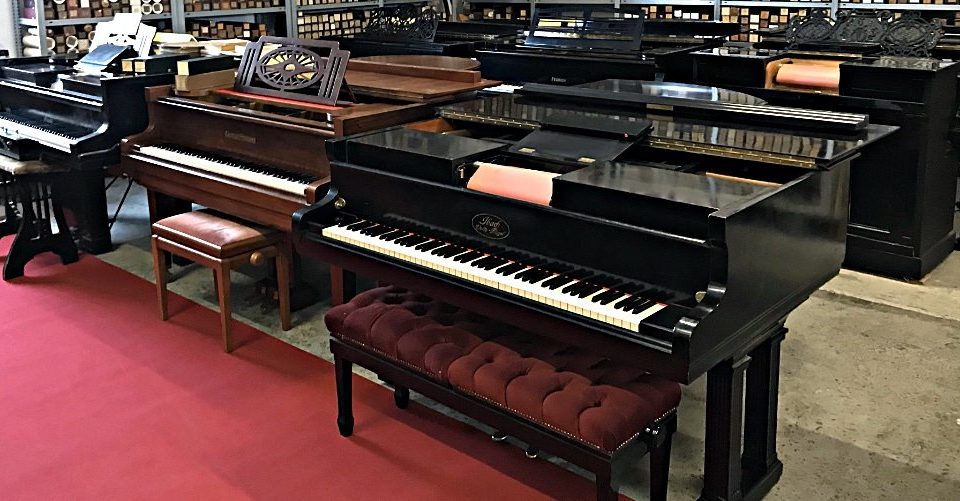
Wie in allen Spezialgebieten, ist es die Herausforderung, überhaupt passende Angebote zu finden. Es sind nur wenige Pianolas auf dem Privat Markt zu finden. Der Kauf
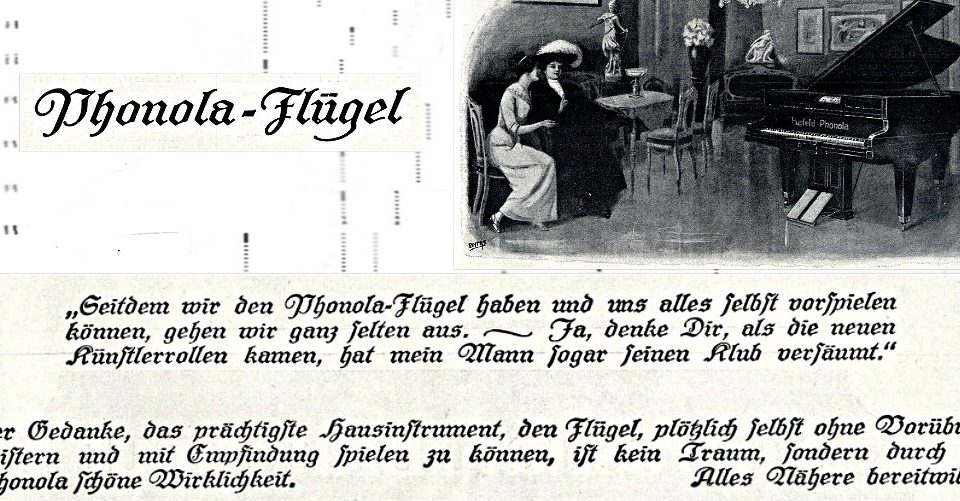
Die Frage beantwortet sich meistens von selbst, wenn ein gutes Pianola zum ersten mal live erlebt wird. So erging es damals auch den allermeisten Interessenten. Bei

Klaviere, Klaviere…, was das Sammlerherz mit viel Freude und Begeisterung meist über Jahre und Jahrzehnte zusammengetragen und genossen hat, muss irgendwann aufgelöst, übergeben, weitergegeben, abgegeben werden.

Aus der Sicht eines Piano Liebhabers am liebsten gar nicht. Und wenn der Tag dann doch kommt, an dem es aus unterschiedlichen Gründen keine einfache Alternative

Nicht jedes Klavier wurde damals -ebenso wie heute- mit einem Schloss und einem Schlüssel ausgeliefert. Warum sollte ein Klavier auch abgeschlossen werden. Tatsächlich werden abgeschlossene Pianos

Viele Klaviere vor 1920 hatten damals sehr notwendige und heute noch sehr dekorative Original-Kerzenleuchter. Nicht in allen Haushalten gab es elektrisches Licht – und schon gar

Am wichtigsten für langanhaltende Spielfreude ist, neben dem guten Piano selbst, eine bequeme und funktionale Sitzgelegenheit. Klavierlehrer und Physiotherapeuten können hier wertvolle Tipps geben. Viele berühmte

Um ein Piano nutzen zu können, braucht es eigentlich nur eine geeignete Sitzgelegenheit und ausreichend Licht für den jeweiligen Anspruch. Accessoires wie Klavierleuchter, Schlüssel, Metronom, Klaviaturdeckel-Klemmschutz,
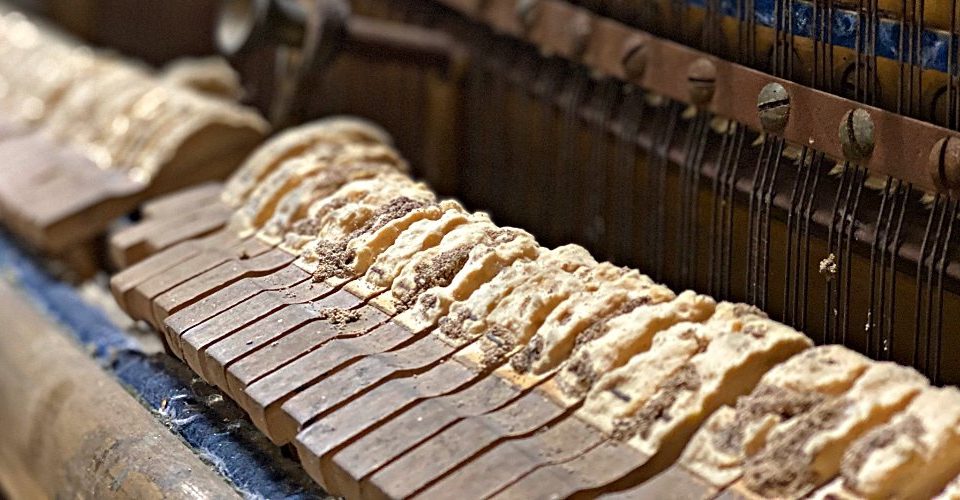
Für die Filze im Piano sind Motten der kritische Schädling. Auch hier sind unbespielte Pianos eher in Gefahr. Oft werden Motten mit alten Teppichen oder Kleidungsstücken

Der Holzwurm, oder genauer, der gemeine Nagekäfer und dessen Larven lieben die weichen Hölzer in den Pianos. An alten Pianos sind oft Spuren von Holzwurmbefall zu

Zur Ehrenrettung, Schädlinge sind es nur, weil wir am Piano oder unserer Gesundheit Schaden davon tragen und dies nicht wollen. So gesehen, sind wir Menschen für

Bei alten Pianos ist der Tastaturbelag der weißen Tasten bis ca. 1910 zumeist aus Elfenbein. Die schwarzen Tastenaufsätze oft aus Ebenholz. Nur wenigen ist bekannt, dass

Als Verbindung zwischen Klavierspieler und akustischer Anlage kommt der Klaviatur und der Mechanik eine große Bedeutung zu. Alte Marken Mechaniken (Schwander, Renner, Keller, Langer, Flemming, etc.)

Risse im Gussrahmen sind selten, und meistens auf a. Materialfehler, b. Transportschäden oder c. Stimmfehler zurückzuführen. Je nachdem wo der Riss sich befindet, kann sich dies

Die ca. 20t Saitenzug eines Pianos lasten über die Stimmwirbel vor allem auf dem hölzernen Stimmstock. Bis auf eine Metall-Innovation von Crasselt&Rähse damals, haben alle Pianos

Die Stege im Piano sind auf den Resonanzboden aufgeleimt und verbinden klangtechnisch die Saiten mit dem Resonanzboden. Diese Stege müssen hohen Belastungen standhalten und sind -da

Die große klingende Holzfläche im Piano unter den Saiten ist am anfälligsten für Rissbildungen. Resonanzböden bestehen aus verleimten Fichtenbrettern und schrumpfen bei zu geringer Luftfeuchte unter

Auch wenn ziemlich jedes Piano unabhängig vom Zustand noch Töne von sich geben kann, stimmt die in Annoncen weit verbreitete Aussage ‚…muss nur gestimmt werden…‘ meistens

Das ist eher die Frage zwischen Oldtimer und Moderne, da mechanische Pianolas heute nicht mehr in Serienfertigung hergestellt werden. Wer das alte Original sucht, den Zauber